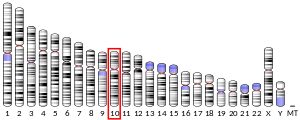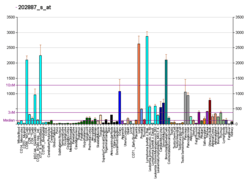DDIT4
DNA-damage-inducible transcript 4 (DDIT4) protein also known as protein regulated in development and DNA damage response 1 (REDD1) is a protein that in humans is encoded by the DDIT4 gene.[5][6]
Function
DDIT4 acts as a negative regulator of mTOR,[7] a serine/threonine kinase that regulates a variety of cellular functions such as growth, proliferation and autophagy.[8] In particular, upregulation of HIF-1 in response to hypoxia upregulates DDIT4,[5] leading to activation of Tsc1/2 via 14–3–3 shuttling [9] and subsequent downregulation of mTOR via Rheb.[10] In addition to hypoxia, DDIT4 expression has also been shown to be activated by DNA damage[11] and energy stress.[12]
Clinical significance
Clinical interest in DDIT4 is based primarily on its effect on mTOR, which has been associated with aging[13] and linked with diseases such as tuberous sclerosis, lymphangioleiomyomatosis,[14] diabetes,[13] and cancer. In particular, the overactivation of mTOR in many cancer types[8] has led to the development of mTOR inhibitors for cancer treatment. DDIT4 has begun to receive attention in this regard via the diabetes drug Metformin which has been shown to reduce cancer risk and increase DDIT4 expression.[15]
References
- GRCh38: Ensembl release 89: ENSG00000168209 - Ensembl, May 2017
- GRCm38: Ensembl release 89: ENSMUSG00000020108 - Ensembl, May 2017
- "Human PubMed Reference:". National Center for Biotechnology Information, U.S. National Library of Medicine.
- "Mouse PubMed Reference:". National Center for Biotechnology Information, U.S. National Library of Medicine.
- Shoshani T, Faerman A, Mett I, Zelin E, Tenne T, Gorodin S, Moshel Y, Elbaz S, Budanov A, Chajut A, Kalinski H, Kamer I, Rozen A, Mor O, Keshet E, Leshkowitz D, Einat P, Skaliter R, Feinstein E (April 2002). "Identification of a novel hypoxia-inducible factor 1-responsive gene, RTP801, involved in apoptosis". Molecular and Cellular Biology. 22 (7): 2283–93. doi:10.1128/MCB.22.7.2283-2293.2002. PMC 133671. PMID 11884613.
- "Entrez Gene: DDIT4 DNA-damage-inducible transcript 4".
- Sofer A, Lei K, Johannessen CM, Ellisen LW (July 2005). "Regulation of mTOR and cell growth in response to energy stress by REDD1". Molecular and Cellular Biology. 25 (14): 5834–45. doi:10.1128/MCB.25.14.5834-5845.2005. PMC 1168803. PMID 15988001.
- Sato T, Nakashima A, Guo L, Coffman K, Tamanoi F (May 2010). "Single amino-acid changes that confer constitutive activation of mTOR are discovered in human cancer". Oncogene. 29 (18): 2746–52. doi:10.1038/onc.2010.28. PMC 2953941. PMID 20190810.
- DeYoung MP, Horak P, Sofer A, Sgroi D, Ellisen LW (January 2008). "Hypoxia regulates TSC1/2-mTOR signaling and tumor suppression through REDD1-mediated 14-3-3 shuttling". Genes & Development. 22 (2): 239–51. doi:10.1101/gad.1617608. PMC 2192757. PMID 18198340.
- Inoki K, Li Y, Xu T, Guan KL (August 2003). "Rheb GTPase is a direct target of TSC2 GAP activity and regulates mTOR signaling". Genes & Development. 17 (15): 1829–34. doi:10.1101/gad.1110003. PMC 196227. PMID 12869586.
- Ellisen LW, Ramsayer KD, Johannessen CM, Yang A, Beppu H, Minda K, Oliner JD, McKeon F, Haber DA (November 2002). "REDD1, a developmentally regulated transcriptional target of p63 and p53, links p63 to regulation of reactive oxygen species". Molecular Cell. 10 (5): 995–1005. doi:10.1016/S1097-2765(02)00706-2. PMID 12453409.
- McGhee NK, Jefferson LS, Kimball SR (May 2009). "Elevated corticosterone associated with food deprivation upregulates expression in rat skeletal muscle of the mTORC1 repressor, REDD1". The Journal of Nutrition. 139 (5): 828–834. doi:10.3945/jn.108.099846. PMC 2714387. PMID 19297425.
- Zoncu R, Efeyan A, Sabatini DM (January 2011). "mTOR: from growth signal integration to cancer, diabetes and ageing". Nature Reviews Molecular Cell Biology. 12 (1): 21–35. doi:10.1038/nrm3025. PMC 3390257. PMID 21157483.
- Sarbassov DD, Ali SM, Sabatini DM (December 2005). "Growing roles for the mTOR pathway". Current Opinion in Cell Biology. 17 (6): 596–603. doi:10.1016/j.ceb.2005.09.009. PMID 16226444.
- Ben Sahra I, Regazzetti C, Robert G, Laurent K, Le Marchand-Brustel Y, Auberger P, Tanti JF, Giorgetti-Peraldi S, Bost F (July 2011). "Metformin, independent of AMPK, induces mTOR inhibition and cell-cycle arrest through REDD1". Cancer Research. 71 (13): 4366–72. doi:10.1158/0008-5472.CAN-10-1769. PMID 21540236.
Further reading
- Ellisen LW (November 2005). "Growth control under stress: mTOR regulation through the REDD1-TSC pathway". Cell Cycle. 4 (11): 1500–02. doi:10.4161/cc.4.11.2139. PMID 16258273.
- Hartley JL, Temple GF, Brasch MA (November 2000). "DNA cloning using in vitro site-specific recombination". Genome Research. 10 (11): 1788–95. doi:10.1101/gr.143000. PMC 310948. PMID 11076863.
- Wiemann S, Weil B, Wellenreuther R, Gassenhuber J, Glassl S, Ansorge W, Böcher M, Blöcker H, Bauersachs S, Blum H, Lauber J, Düsterhöft A, Beyer A, Köhrer K, Strack N, Mewes HW, Ottenwälder B, Obermaier B, Tampe J, Heubner D, Wambutt R, Korn B, Klein M, Poustka A (March 2001). "Toward a catalog of human genes and proteins: sequencing and analysis of 500 novel complete protein coding human cDNAs". Genome Research. 11 (3): 422–35. doi:10.1101/gr.GR1547R. PMC 311072. PMID 11230166.
- Simpson JC, Wellenreuther R, Poustka A, Pepperkok R, Wiemann S (September 2000). "Systematic subcellular localization of novel proteins identified by large-scale cDNA sequencing". EMBO Reports. 1 (3): 287–92. doi:10.1093/embo-reports/kvd058. PMC 1083732. PMID 11256614.
- Kim JR, Lee SR, Chung HJ, Kim S, Baek SH, Kim JH, Kim YS (October 2003). "Identification of amyloid beta-peptide responsive genes by cDNA microarray technology: involvement of RTP801 in amyloid beta-peptide toxicity". Experimental & Molecular Medicine. 35 (5): 403–11. doi:10.1038/emm.2003.53. PMID 14646594.
- Brandenberger R, Wei H, Zhang S, Lei S, Murage J, Fisk GJ, Li Y, Xu C, Fang R, Guegler K, Rao MS, Mandalam R, Lebkowski J, Stanton LW (June 2004). "Transcriptome characterization elucidates signaling networks that control human ES cell growth and differentiation". Nature Biotechnology. 22 (6): 707–16. doi:10.1038/nbt971. PMID 15146197.
- Lee M, Bikram M, Oh S, Bull DA, Kim SW (May 2004). "Sp1-dependent regulation of the RTP801 promoter and its application to hypoxia-inducible VEGF plasmid for ischemic disease". Pharmaceutical Research. 21 (5): 736–41. doi:10.1023/B:PHAM.0000026421.09367.b3. PMID 15180327.
- Wiemann S, Arlt D, Huber W, Wellenreuther R, Schleeger S, Mehrle A, Bechtel S, Sauermann M, Korf U, Pepperkok R, Sültmann H, Poustka A (October 2004). "From ORFeome to biology: a functional genomics pipeline". Genome Research. 14 (10B): 2136–44. doi:10.1101/gr.2576704. PMC 528930. PMID 15489336.
- Schwarzer R, Tondera D, Arnold W, Giese K, Klippel A, Kaufmann J (February 2005). "REDD1 integrates hypoxia-mediated survival signaling downstream of phosphatidylinositol 3-kinase". Oncogene. 24 (7): 1138–49. doi:10.1038/sj.onc.1208236. PMID 15592522.
- Corradetti MN, Inoki K, Guan KL (March 2005). "The stress-inducted proteins RTP801 and RTP801L are negative regulators of the mammalian target of rapamycin pathway". The Journal of Biological Chemistry. 280 (11): 9769–72. doi:10.1074/jbc.C400557200. PMID 15632201.
- Sofer A, Lei K, Johannessen CM, Ellisen LW (July 2005). "Regulation of mTOR and cell growth in response to energy stress by REDD1". Molecular and Cellular Biology. 25 (14): 5834–45. doi:10.1128/MCB.25.14.5834-5845.2005. PMC 1168803. PMID 15988001.
- Oh JH, Yang JO, Hahn Y, Kim MR, Byun SS, Jeon YJ, Kim JM, Song KS, Noh SM, Kim S, Yoo HS, Kim YS, Kim NS (December 2005). "Transcriptome analysis of human gastric cancer". Mammalian Genome. 16 (12): 942–54. doi:10.1007/s00335-005-0075-2. PMID 16341674.
- Mehrle A, Rosenfelder H, Schupp I, del Val C, Arlt D, Hahne F, Bechtel S, Simpson J, Hofmann O, Hide W, Glatting KH, Huber W, Pepperkok R, Poustka A, Wiemann S (January 2006). "The LIFEdb database in 2006". Nucleic Acids Research. 34 (Database issue): D415–8. doi:10.1093/nar/gkj139. PMC 1347501. PMID 16381901.
- Lim J, Hao T, Shaw C, Patel AJ, Szabó G, Rual JF, Fisk CJ, Li N, Smolyar A, Hill DE, Barabási AL, Vidal M, Zoghbi HY (May 2006). "A protein-protein interaction network for human inherited ataxias and disorders of Purkinje cell degeneration". Cell. 125 (4): 801–14. doi:10.1016/j.cell.2006.03.032. PMID 16713569.
- Malagelada C, Ryu EJ, Biswas SC, Jackson-Lewis V, Greene LA (September 2006). "RTP801 is elevated in Parkinson brain substantia nigral neurons and mediates death in cellular models of Parkinson's disease by a mechanism involving mammalian target of rapamycin inactivation". The Journal of Neuroscience. 26 (39): 9996–10005. doi:10.1523/JNEUROSCI.3292-06.2006. PMC 6674487. PMID 17005863.
- Jin HO, An S, Lee HC, Woo SH, Seo SK, Choe TB, et al. (July 2007). "Hypoxic condition- and high cell density-induced expression of Redd1 is regulated by activation of hypoxia-inducible factor-1alpha and Sp1 through the phosphatidylinositol 3-kinase/Akt signaling pathway". Cellular Signalling. 19 (7): 1393–403. doi:10.1016/j.cellsig.2006.12.014. PMID 17307335.




